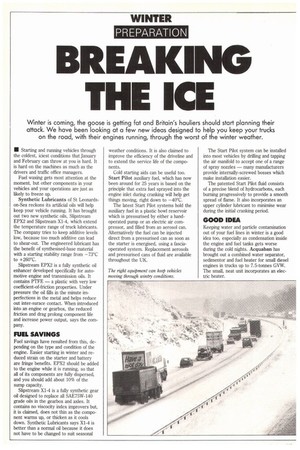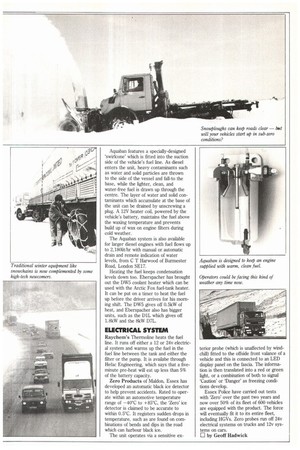BREAKING THE ICE
Page 50

Page 51

If you've noticed an error in this article please click here to report it so we can fix it.
• Starting and running vehicles through the coldest, iciest conditions that January and February can throw at you is hard. It is hard on the machines as much as the drivers and traffic office managers.
Fuel waxing gets most attention at the moment, but other components in your vehicles and your operations are just as likely to freeze up.
Synthetic Lubricants of St Leonardson-Sea reckons its artificial oils will help keep your vehicle running. It has brought out two new synthetic oils, Slipstream EPX2 and Slipstream X1-4, which extend the temperature range of truck lubricants. The company tries to keep additive levels low, because too much additive can lead to shear-out. The engineered lubricant has the benefit of synthesised-base material with a starting stability range from —73°C to +260°C.
Slipstream EPX2 is a fully synthetic oil enhancer developed specifically for automotive engine and transmission oils. It contains PTFE — a plastic with very low coefficient-of-friction properties. Under pressure the oil fills in the minute imperfections in the metal and helps reduce out inter-surace contact. When introduced into an engine or gearbox, the reduced friction and drag prolong component life and increase power output, says the company.
FUEL SAVINGS
Fuel savings have resulted from this, depending on the type and condition of the engine. Easier starting in winter and reduced strain on the starter and battery are fringe benefits. EPX2 should be added to the engine while it is running, so that all of its components are fully dispersed, and you should add about 10% of the sump capacity.
Slipstream X1-4 is a fully synthetic gear oil designed to replace all SAE75W-140 grade oils in the gearbox and axles. It contains no viscocity index improvers but, it is claimed, does not thin as the component warms up, or thicken as it cools down. Synthetic Lubricants says X1-4 is better than a normal oil because it does not have to be changed to suit seasonal weather conditions. It is also claimed to improve the efficiency of the driveline and to extend the service life of the components.
Cold starting aids can be useful too. Start Pilot auxiliary fuel, which has now been around for 25 years is based on the principle that extra fuel sprayed into the engine inlet during cranking will help get things moving, right down to —40°C.
The latest Start Pilot systems hold the auxiliary fuel in a plastic bowl reservoir which is pressurised by either a handoperated pump or an electric air compressor, and filled from an aerosol can. Alternatively the fuel can be injected direct from a pressurised can as soon as the starter is energised, using a fasciaoperated system. Replacement aerosols and pressurised cans of fluid are available throughout the UK. The Start Pilot system can be installed into most vehicles by drilling and tapping the air manifold to accept one of a range of spray nozzles — many manufacturers provide internally-screwed bosses which make installation easier.
The patented Start Pilot fluid consists of a precise blend of hydrocarbons, each burning progressively to provide a smooth spread of flame. It also incorporates an upper cylinder lubricant to minimise wear during the initial cranking period.
GOOD IDEA
Keeping water and particle contamination out of your fuel lines in winter is a good idea too, especially as condensation inside the engine and fuel tanks gets worse during the cold nights. Acquaban has brought out a combined water separator, sedirnentor and fuel heater for small diesel engines in trucks up to 7.5-tonnes GVW. The small, neat unit incorporates an electric heater. Aquaban features a specially-designed `swirlcone' which is fitted into the suction side of the vehicle's fuel line. As diesel enters the unit, heavy contaminants such as water and solid particles are thrown to the side of the vessel and fall-to the base, while the lighter, clean, and water-free fuel is drawn up through the centre. The layer of water and solid contaminants which accumulate at the base of the unit can be drained by unscrewing a plug. A 12V heater coil, powered by the vehicle's battery, maintains the fuel above the waxing temperature and prevents build up of wax on engine filters during cold weather.
The Aquaban system is also available for larger diesel engines with fuel flows up to 2,180lithir with manual or automatic drain and remote indication of water levels, from C T Harwood of Burmester Road, London SE17.
Heating the fuel keeps condensation levels down too. Eberspacher has brought out the DW5 coolant heater which can be used with the Arctic Fox fuel-tank heater. It can be put on a timer to heat the fuel up before the driver arrives for his morning shift. The DW5 gives off 0.5kW of heat, and Eberspacher also has bigger units, such as the DlL which gives oft 1.8kW and the 8kW D7L.
ELECTRICAL SYSTEM
Raychem's Thermoline heats the fuel line. It runs off either a 12 or 24v electrical system and warms up the fuel in the fuel line between the tank and either the filter or the pump. It is availabe through Hefac Engineering, which says that a fiveminute pre-heat will eat up less than 5% of the battery capacity.
Zero Products of Maldon, Essex has developed an automatic black ice detector to help prevent accidents. Rated to operate within an automotive temperature range of –40°C to +85°C, the 'Zero' ice detector is claimed to be accurate to within 0.5°C. It registers sudden drops in temperature, such as are found on combinations of bends and dips in the road which can harbour black ice.
The unit operates via a sensitive ex tenor probe (which is unaffected by windchill) fitted to the offside front valance of a vehicle and this is connected to an LED display panel on the fascia. The information is then translated into a red or green light, or a combination of both to signal 'Caution' or 'Danger' as freezing conditions develop.
Essex Police have carried out tests with 'Zero' over the past two years and now over 50% of its fleet of 600 vehicles are equipped with the product. The force will eventually fit it to its entire fleet, including HGVs. Zero probes run off 24v electrical systems on trucks and 12v systems on cars.












































































































































































